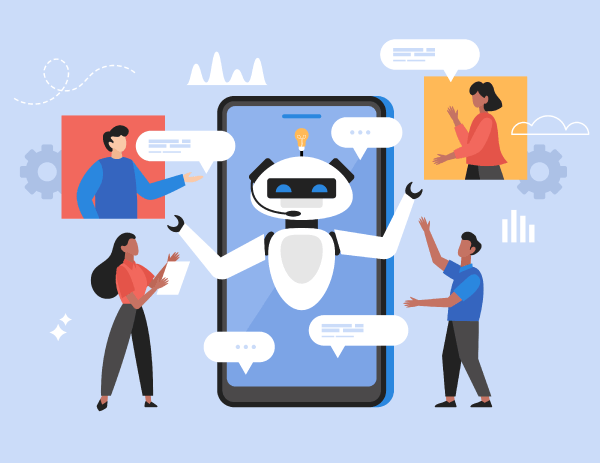Hello everyone, I’m excited to share a technology that’s rapidly transforming how businesses interact with the world: Conversational AI. You’ve probably heard the buzz, but let’s really look into it. It’s more than just chatbots. It’s a fundamental shift in human-computer interaction, and understanding it is crucial for businesses looking to stay ahead.

How Conversational AI Works: The Technology Behind the Talk
At its heart, Conversational AI is about enabling computers to understand and respond to human language in a way that feels natural and conversational. This isn’t just about recognizing keywords. It’s about deciphering intent, context, and even sentiment. So, how does this magic happen? It’s built on a stack of sophisticated technologies.
NLP and ML Technology:
Natural Language Processing (NLP): This is the bedrock of Conversational AI. NLP allows machines to process and understand human language, whether it’s spoken or written. Think of it as the AI’s ears and reading comprehension. NLP breaks down language into components a computer can understand, analyzing grammar, syntax, semantics, and even nuances like sarcasm.
Machine Learning (ML): Machine learning algorithms allow Conversational AI systems to learn from data. The more conversations a system has, the better it becomes at understanding different phrasing, accents, and even unpredictable user inputs. For example, ML helps the AI learn from past interactions to provide more relevant and personalized responses in the future. This is crucial for creating truly engaging and helpful conversational experiences.
Dialogue Management Process:
Dialogue Management: This component is the brain orchestrating the conversation flow. Dialogue management ensures that the conversation is coherent, contextually relevant, and progresses towards a goal. It remembers past turns in the conversation, manages context, and decides on the appropriate response at each step. It’s what prevents the AI from sounding like it has amnesia after each sentence and keeps the conversation on track.
Essentially, Conversational AI systems take user input (text or voice), NLP processes it to understand the meaning and intent. Dialogue management determines the best response based on context and goals, and then NLP generates a human-like output. This entire process happens in milliseconds, creating the illusion of a real-time, intelligent conversation.
Applications
The applications of Conversational AI are vast and continue to expand as the technology matures. It’s no longer confined to simple chatbots. It’s revolutionizing customer service, marketing, internal operations, and much more. Here are some key areas where Conversational AI is making a significant impact:
Customer Service and Its sales:
Customer Service: This is perhaps the most visible and impactful application. Conversational AI-powered chatbots and virtual assistants are transforming customer service by providing instant, 24/7 support. They can answer FAQs, resolve simple issues, and even escalate complex issues to human agents seamlessly. This leads to improved customer satisfaction, reduced wait times, and significant cost savings for businesses. Think about those instant chat windows you see on websites – many are powered by Conversational AI.
Marketing and Sales: Conversational AI is becoming a powerful tool for personalized marketing and sales engagement. Chatbots can qualify leads, provide product recommendations, answer pre-sales questions, and even guide customers through the purchasing process. They can personalize interactions based on user data and past behavior, leading to higher conversion rates and improved customer engagement. Imagine a chatbot that understands your preferences and suggests products you might actually be interested in – that’s the power of Conversational AI in marketing.

Internal Operations and Other Industries:
Employee Support: Beyond external customer interactions, Conversational AI is streamlining internal operations and improving employee productivity. Virtual assistants can automate tasks like answering employee FAQs, providing IT support, scheduling meetings, and accessing internal knowledge bases. This frees up human employees to focus on more strategic and complex tasks, boosting overall efficiency and employee satisfaction. Think of an internal chatbot that can instantly answer your HR or IT questions, saving you time and frustration.
E-commerce & Retail: Conversational AI enhances the online shopping experience by providing personalized product recommendations, order tracking, and customer support directly within e-commerce platforms. In retail settings, voice-activated assistants can help customers find products, provide information, and even process payments. This creates a more engaging and convenient shopping experience, both online and offline.
Healthcare: Conversational AI is finding applications in healthcare for appointment scheduling, medication reminders, preliminary symptom checking, and providing patients with access to health information. While still in early stages, it has the potential to improve patient access to care and alleviate the workload on healthcare professionals.
These are just a few examples, and the list continues to grow. As Conversational AI technology advances and becomes more accessible, we’ll see even more innovative applications emerge across diverse industries.
Future Trends in Conversational AI: What’s Next?
The field of Conversational AI is dynamic and rapidly evolving. Looking ahead, several exciting trends are shaping its future, promising even more sophisticated and human-like interactions:
Personalization and Diversity:
Hyper-Personalization:The future of Conversational AI is deeply intertwined with personalization. Expect to see systems that go beyond basic personalization to offer hyper-personalized experiences. This means understanding individual user preferences, past interactions, real-time context, and even emotional states to deliver highly tailored and relevant responses. Imagine a chatbot that not only knows your name but also remembers your past purchases, preferred communication style, and even your current mood to provide truly personalized assistance.
Multimodality: Conversational AI is moving beyond text and voice to incorporate multiple modalities. Future systems will seamlessly integrate with images, videos, and other sensory inputs to create richer and more immersive conversational experiences. For example, you might be able to upload a picture of a broken part to a customer service chatbot, and it can visually diagnose the issue and provide relevant solutions. This multimodal approach will make interactions more natural and efficient.
AR, VR, MR and Generative AI:
Emotional Intelligence: One of the most fascinating frontiers is equipping Conversational AI with emotional intelligence. This involves enabling systems to detect, understand, and respond to human emotions. Imagine chatbots that can recognize frustration in a customer’s voice and adapt their tone and responses accordingly to de-escalate the situation. Emotional intelligence will be crucial for building truly empathetic and human-like conversational experiences.
Integration with AR, VR, and MR: Conversational AI is poised to play a key role in the metaverse and extended reality (XR) environments. Imagine interacting with virtual assistants in augmented reality or having natural language conversations within virtual worlds. This integration will unlock new possibilities for immersive experiences in gaming, training, collaboration, and more.
Generative AI Integration: The rise of generative AI models is set to further revolutionize Conversational AI. These models can generate more creative, nuanced, and human-like text responses, making conversations even more natural and engaging. Generative AI can also help overcome some limitations of traditional rule-based chatbots, enabling more flexible and open-ended conversations.

Conversational AI is no longer a futuristic concept. It’s a present-day reality that’s transforming businesses and shaping the future of human-computer interaction. Understanding how it works, its diverse applications, and the exciting future trends is essential for anyone looking to leverage the power of AI in today’s digital landscape. As a Marketing Manager, I see immense potential in this technology to enhance customer experiences, streamline operations, and drive business growth. The conversation has just begun!
You can also read:
How to Add a DeepSeek Chatbot to Your Website in Three Steps



